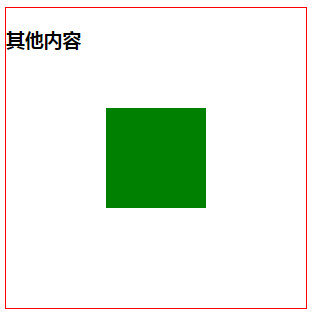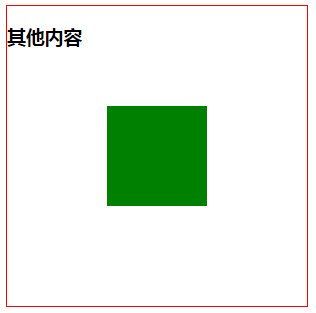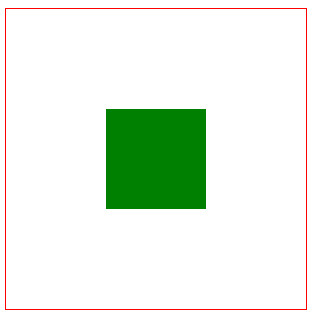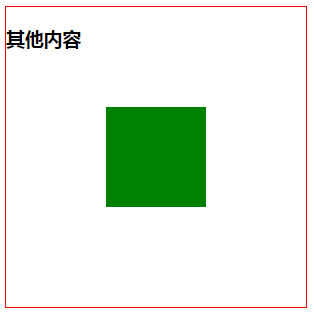1. 水平居中(margin: auto;)子父元素宽度固定,子元素上设置 margin: auto; 子元素不能设置浮动,否则居中失效。
#div1{ width: 300px; height: 300px; border: 1px solid red; } #div1 p { width: 100px; height: 100px; background-color: green; /*float: left; !*如果设置了浮动,则自动居中就会失效。*!*/ margin: 0 auto; } <div id="div1"> <p></p> </div>

2. 水平居中,子父元素宽度固定,父元素设置 text-align: center;
子元素设置 display: inline-block; 子元素不能设置浮动,否则居中失效。
如果将元素设置为 inline , 则元素的宽高设置会失效,这就需要内容来撑起盒子
#div2 { width: 300px; height: 300px; border: 1px solid red; /*position: relative;*/ text-align: center; } #div2 p{ width: 100px; height: 100px; background-color: green; margin: 0; /*float: left; !*如果设置了浮动,则自动居中就会失效。*!*/ display: inline-block; /*display: inline;*/ /*display: inline-flex;*/ } <div id="div2"> <h4>其他内容</h4> <p></p> <h3>其他内容</h3> </div>

1. 水平垂直居中,子元素相对于父元素绝对定位,
子元素top,left设置为50%,子元素margin的top,left减去自身高,宽的一半。
#div3 { width: 300px; height: 300px; border: 1px solid red; position: relative; } #div3 p { width: 100px; height: 100px; background-color: green; /*margin-top: 10%; !*百分比相对于父元素*!*/ /*padding-top: 10%; !*百分比相对于父元素*!*/ position: absolute; top: 50%; left: 50%; margin-top: -50px; margin-left: -50px; } <div id="div3"> <p></p> <h3>其他内容</h3> </div>

2. 水平垂直居中,子元素相对于父元素绝对定位,
将子元素的top,right,bottom,left均设为0,然后设置子元素 margin: auto;
#div4{ width: 300px; height: 300px; border: 1px solid red; position: relative; } #div4 p{ width: 100px; height: 100px; background-color: green; position: absolute; top: 0; left: 0; bottom: 0; right: 0; margin: auto; } <div id="div4"> <p></p> <h3>其他内容</h3> </div>

3. 水平垂直居中,父元素设置 display: table-cell; vertical-align: middle;
子元素设置 margin: auto;
这种方式是让所有的子元素作为一个整体垂直居中,并不能单独指定某一个子元素居中
#div5{ width: 300px; height: 300px; border: 1px solid red; display: table-cell; vertical-align: middle; } #div5 p{ width: 100px; height: 100px; background-color: green; margin: auto; } <div id="div5"> <p></p> </div>

4. 水平垂直居中,子元素相对定位,top,let设为50%,transform: translate(-50%, -50%);
这种方式并不会释放子元素在文档中所占的位置。
#div6{ width: 300px; height: 300px; border: 1px solid red; } #div6 p { width: 100px; height: 100px; background-color: green; margin: 0; position: relative; top: 50%; left: 50%; transform: translate(-50%, -50%); } <div id="div6"> <p></p> <h3>其他内容</h3> </div>

5. 水平垂直居中,子元素相对于父元素绝对定位,
子元素top,let设为50%,transform: translate(-50%, -50%);
这种方式会释放子元素在文档中所占的位置
#div7{ width: 300px; height: 300px; border: 1px solid red; position: relative; } #div7 p { width: 100px; height: 100px; background-color: green; margin: 0; position: absolute; top: 50%; left: 50%; transform: translate(-50%, -50%); } <div id="div7"> <p></p> <h3>其他内容</h3> </div>

6. 水平垂直居中,父元素设置 display: flex; justify-content: center; align-items: center;
justify-content: center; 是让所有的子元素作为一个整体居中。
#div8{ width: 300px; height: 300px; border: 1px solid red; display: flex; justify-content: center; align-items: center; } #div8 p{ width: 100px; height: 100px; background-color: green; margin: 0; } <div id="div8"> <p></p> </div>

转自:https://www.cnblogs.com/yingtoumao/p/11541256.html感谢

